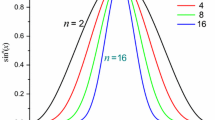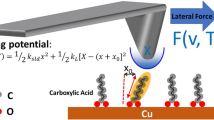Abstract
A model sliding potential, based on Prandtl–Tomlinson type models, is proposed for analyzing the temperature- and velocity-dependences of sliding processes at the interface between a tip and an adsorbed molecular layer. The proposed simple periodic potential has a parabolic form up to a critical distance, corresponding to the onset of detachment, at which point it becomes flat. The simplicity of the model will enable it to be used to analyze complex molecular interfaces, such as molecular films, mechanically induced chemical reactions or biological interfaces such as muscles or transport molecules. A simple analytical model is presented for the resulting velocity- and temperature-dependences of the friction force for the sliding of a compliant atomic force microscopy tip over an array of molecular species adsorbed on a surface, when only considering transitions of the tip in the forward direction (overall sliding direction). The validity of the analysis is tested by using kinetic Monte Carlo (kMC) simulations of the sliding over the molecular potential. This simulation provides excellent agreement with the analytic model, except for some slight differences that arise from the way in which the simulations calculate the lateral force compared to the analytical model. However, significant deviations are found between the kMC simulations and the analytical model when the possibility of both forward and reverse transitions are included, in particular at high sliding velocities and low temperatures. The origin of these effects are discussed in the manuscript, but result in superlubricious behavior, that is, vanishing friction, in particular at low sliding velocities.
Graphical Abstract









Similar content being viewed by others
Data Availability
Data available in article or supplementary material.
References
Furlong, O.J., Miller, B.P., Kotvis, P., Tysoe, W.T.: Low-temperature, shear-induced tribofilm formation from dimethyl disulfide on copper. ACS Appl. Mater. Interfaces. 3, 795–800 (2011)
Furlong, O., Miller, B., Tysoe, W.T.: Shear-induced boundary film formation from dialkyl sulfides on copper. Wear 274–275, 183–187 (2012)
Miller, B., Furlong, O., Tysoe, W.: The kinetics of shear-induced boundary film formation from dimethyl disulfide on copper. Tribol. Lett. 49, 39–46 (2013)
Adams, H.L., Garvey, M.T., Ramasamy, U.S., Ye, Z., Martini, A., Tysoe, W.T.: Shear-induced mechanochemistry: pushing molecules around. J. Phys. Chem. C 119, 7115–7123 (2015)
Adams, H., Miller, B.P., Kotvis, P.V., Furlong, O.J., Martini, A., Tysoe, W.T.: In situ measurements of boundary film formation pathways and kinetics: dimethyl and diethyl disulfide on copper. Tribol. Lett. 62, 1–9 (2016)
Adams, H., Miller, B.P., Furlong, O.J., Fantauzzi, M., Navarra, G., Rossi, A., et al.: Modeling mechanochemical reaction mechanisms. ACS Appl. Mater. Interfaces. 9, 26531–26538 (2017)
Yeon, J., He, X., Martini, A., Kim, S.H.: Mechanochemistry at solid surfaces: polymerization of adsorbed molecules by mechanical shear at tribological interfaces. ACS Appl. Mater. Interfaces. 9, 3142–3148 (2017)
Chen, L., Wen, J., Zhang, P., Yu, B., Chen, C., Ma, T., et al.: Nanomanufacturing of silicon surface with a single atomic layer precision via mechanochemical reactions. Nat. Commun. 9, 1542 (2018)
Gosvami, N.N., Bares, J.A., Mangolini, F., Konicek, A.R., Yablon, D.G., Carpick, R.W.: Mechanisms of antiwear tribofilm growth revealed in situ by single-asperity sliding contacts. Science 348, 102–106 (2015)
Felts, J.R., Oyer, A.J., Hernández, S.C., Whitener, K.E., Jr., Robinson, J.T., Walton, S.G., et al.: Direct mechanochemical cleavage of functional groups from graphene. Nat. Commun. 6, 1–7 (2015)
Raghuraman, S., Elinski, M.B., Batteas, J.D., Felts, J.R.: Driving surface chemistry at the nanometer scale using localized heat and stress. Nano Lett. 17, 2111–2117 (2017)
He, X., Kim, S.H.: Surface chemistry dependence of mechanochemical reaction of adsorbed molecules—an experimental study on tribopolymerization of α-Pinene on metal, metal oxide, and carbon surfaces. Langmuir 34, 2432–2440 (2018)
Bell, G.: Models for the specific adhesion of cells to cells. Science 200, 618–627 (1978)
Kuwahara, T., Romero, P.A., Makowski, S., Weihnacht, V., Moras, G., Moseler, M.: Mechano-chemical decomposition of organic friction modifiers with multiple reactive centres induces superlubricity of ta-C. Nat. Commun. 10, 151 (2019)
Carpick, R.W., Salmeron, M.: Scratching the surface: fundamental investigations of tribology with atomic force microscopy. Chem. Rev. 97, 1163–1194 (1997)
Gnecco, E., Bennewitz, R., Gyalog, T., Loppacher, C., Bammerlin, M., Meyer, E., et al.: Velocity dependence of atomic friction. Phys. Rev. Lett. 84, 1172–1175 (2000)
Gnecco, E., Bennewitz, R., Gyalog, T., Meyer, E.: Friction experiments on the nanometre scale. J. Phys. 13, R619–R642 (2001)
Bennewitz, R., Gnecco, E., Gyalog, T., Meyer, E.: Atomic friction studies on well-defined surfaces. Tribol. Lett. 10, 51–56 (2001)
Tomlinson, G.A.: A molecular theory of friction. Philos. Mag. 7, 905 (1929)
Prandtl, L.: Ein Gedankenmodell zur kinetischen Theorie der festen Körper. Z. Angew. Math. Mech. 8, 85 (1928)
Sang, Y., Dube, M., Grant, M.: Thermal effects on atomic friction. Phys. Rev. Lett. 87, 174301 (2001)
Riedo, E., Gnecco, E., Bennewitz, R., Meyer, E., Brune, H.: Interaction potential and hopping dynamics governing sliding friction. Phys. Rev. Lett. 91, 084502 (2003)
Fusco, C., Fasolino, A.: Velocity dependence of atomic-scale friction: a comparative study of the one- and two-dimensional Tomlinson model. Phys. Rev. B 71, 045413 (2005)
Socoliuc, A., Bennewitz, R., Gnecco, E., Meyer, E.: Transition from stick-slip to continuous sliding in atomic friction: entering a new regime of ultralow friction. Phys. Rev. Lett. 92, 134301 (2004)
Porto, M., Zaloj, V., Urbakh, M., Klafter, J.: Macroscopic versus microscopic description of friction: from Tomlinson model to shearons. Tribol. Lett. 9, 45–54 (2000)
Srinivasan, M., Walcott, S.: Binding site models of friction due to the formation and rupture of bonds: State-function formalism, force-velocity relations, response to slip velocity transients, and slip stability. Phys. Rev. E 80, 046124 (2009)
Lacker, H.M., Peskin, C.S.: A mathematical method for the unique determination of cross-bridge properties from steady-state mechanical and energetic experiments on macroscopic muscle. Lectures Math. Life Sci. 16, 32 (1986)
Huxley, A.F.: Muscle structure and theories of contraction. Prog. Biophys. Biophys. Chem. 7, 255–318 (1957)
Filippov, A.E., Klafter, J., Urbakh, M.: Friction through dynamical formation and rupture of molecular bonds. Phys. Rev. Lett. 92, 135503 (2004)
Barel, I., Urbakh, M., Jansen, L., Schirmeisen, A.: Temperature dependence of friction at the nanoscale: when the unexpected turns normal. Tribol. Lett. 39, 311–319 (2010)
Barel, I., Urbakh, M., Jansen, L., Schirmeisen, A.: Unexpected temperature and velocity dependencies of atomic-scale stick-slip friction. Phys. Rev. B 84, 115417 (2011)
Barel, I., Urbakh, M., Jansen, L., Schirmeisen, A.: Multibond dynamics of nanoscale friction: the role of temperature. Phys. Rev. Lett. 104, 066104 (2010)
Eyring, H.: Viscosity, plasticity, and diffusion as examples of absolute reaction rates. J. Chem. Phys. 4, 283–291 (1936)
Kauzmann, W., Eyring, H.: The viscous flow of large molecules. J. Am. Chem. Soc. 62, 3113–3125 (1940)
Spikes, H., Tysoe, W.: On the commonality between theoretical models for fluid and solid friction wear and tribochemistry. Tribol. Lett. 59, 1–14 (2015)
Bliznyuk, V.N., Everson, M.P., Tsukruk, V.V.: Nanotribological properties of organic boundary lubricants: langmuir films versus self-assembled monolayers. J. Tribol. 120, 489–495 (1998)
Zhang, L., Leng, Y., Jiang, S.: Tip-based hybrid simulation study of frictional properties of self-assembled monolayers: effects of chain length, terminal group, scan direction, and scan velocity. Langmuir 19, 9742–9747 (2003)
Tsukruk, V.V., Everson, M.P., Lander, L.M., Brittain, W.J.: Nanotribological properties of composite molecular films: C60 anchored to a self-assembled monolayer. Langmuir 12, 3905–3911 (1996)
van der Vegte, E.W., Subbotin, A., Hadziioannou, G., Ashton, P.R., Preece, J.A.: Nanotribological properties of unsymmetrical n-Dialkyl sulfide monolayers on gold: effect of chain length on adhesion, friction, and imaging. Langmuir 16, 3249–3256 (2000)
Liu, Y., Evans, D.F., Song, Q., Grainger, D.W.: Structure and frictional properties of self-assembled surfactant monolayers. Langmuir 12, 1235–1244 (1996)
Brewer, N.J., Beake, B.D., Leggett, G.J.: Friction force microscopy of self-assembled monolayers: influence of adsorbate alkyl chain length, terminal group chemistry, and scan velocity. Langmuir 17, 1970–1974 (2001)
Pan, Y.-S., Xiong, D.-S., Ma, R.-Y.: A study on the friction properties of poly(vinyl alcohol) hydrogel as articular cartilage against titanium alloy. Wear 262, 1021–1025 (2007)
Pan, Y., Xiong, D.: Friction properties of nano-hydroxyapatite reinforced poly(vinyl alcohol) gel composites as an articular cartilage. Wear 266, 699–703 (2009)
Gong, J., Iwasaki, Y., Osada, Y., Kurihara, K., Hamai, Y.: Friction of Gels. 3. Friction on solid surfaces. J. Phys. Chem. B 103, 6001–6006 (1999)
Chang, D.P., Dolbow, J.E., Zauscher, S.: Switchable friction of stimulus-responsive hydrogels. Langmuir 23, 250–257 (2007)
Reale, E.R., Dunn, A.C.: Poroelasticity-driven lubrication in hydrogel interfaces. Soft Matter 13, 428–435 (2017)
Shoaib, T., Espinosa-Marzal, R.M.: Insight into the viscous and adhesive contributions to hydrogel friction. Tribol. Lett. 66, 96 (2018)
Weymouth, A.J., Hofmann, T., Giessibl, F.J.: Quantifying molecular stiffness and interaction with lateral force microscopy. Science 343, 1120–1122 (2014)
Cappella, B., Dietler, G.: Force-distance curves by atomic force microscopy. Surf. Sci. Rep. 34, 1–104 (1999)
Evans, M.G., Polanyi, M.: Some applications of the transition state method to the calculation of reaction velocities, especially in solution. Trans. Faraday Soc. 31, 875–894 (1935)
Marcus, R.A.: On the theory of oxidation-reduction reactions involving electron transfer I. J. Chem. Phys. 24, 966–978 (1956)
Gnecco, E., Bennewitz, R., Socoliuc, A., Meyer, E.: Friction and wear on the atomic scale. Wear 254, 859–862 (2003)
Gnecco, E., Roth, R., Baratoff, A.: Analytical expressions for the kinetic friction in the Prandtl-Tomlinson model. Phys. Rev. B 86, 035443 (2012)
Krylov, S.Y., Frenken, J.W.M.: The physics of atomic-scale friction: Basic considerations and open questions. Phys. Status Solidi B 251, 711–736 (2014)
Furlong, O.J., Manzi, S.J., Pereyra, V.D., Bustos, V., Tysoe, W.T.: Kinetic Monte Carlo theory of sliding friction. Phys. Rev. B 80, 153408 (2009)
Furlong, O.J., Manzi, S.J., Pereyra, V.D., Bustos, V., Tysoe, W.T.: Monte Carlo simulations for Tomlinson sliding models for non-sinusoidal periodic potentials. Tribol. Lett. 39, 177–180 (2010)
Manzi, S., Tysoe, W., Furlong, O.: Temperature dependences in the Tomlinson/Prandtl model for atomic sliding friction. Tribol. Lett. 55, 363–369 (2014)
Furlong, O., Manzi, S., Martini, A., Tysoe, W.: Influence of potential shape on constant-force atomic-scale sliding friction models. Tribol. Lett. 60, 1–9 (2015)
Sales, J.L., Uñac, R.O., Gargiulo, M.V., Bustos, V., Zgrablich, G.: Monte Carlo simulation of temperature programmed desorption spectra: a guide through the forest for monomolecular adsorption on a square lattice. Langmuir 12, 95–100 (1996)
Bondi, A.: Van der Waals volumes and dadii. J. Phys. Chem. 68, 441–451 (1964)
Hänggi, P., Talkner, P., Borkovec, M.: Reaction-rate theory: fifty years after Kramers. Rev. Mod. Phys. 62, 251–341 (1990)
Roth, R., Glatzel, T., Steiner, P., Gnecco, E., Baratoff, A., Meyer, E.: Multiple slips in atomic-scale friction: an indicator for the lateral contact damping. Tribol. Lett. 39, 63–69 (2010)
Pollak, E.: Variational transition state theory for activated rate processes. J. Chem. Phys. 93, 1116–1124 (1990)
Acknowledgements
We gratefully acknowledge the Civil, Mechanical and Manufacturing Innovation (CMMI) Division of the National Science Foundation under Grant Nos. 1634340 and 2020525 for support of this work. GDK thanks the Fulbright Foundation for support of this work.
Author information
Authors and Affiliations
Contributions
All authors contributed equally to this work.
Corresponding author
Ethics declarations
Ethical Approval
All ethical responsibilities were respected by the authors.
Additional information
Publisher's Note
Springer Nature remains neutral with regard to jurisdictional claims in published maps and institutional affiliations.
Supplementary Information
Below is the link to the electronic supplementary material.
11249_2021_1523_MOESM1_ESM.docx
Supplementary file1 See Supplementary Material for analysis of the P-T Model for a sinusoidal potential, a derivation of Eact (F) for molecular sliding, a derivation of the velocity dependence of sliding, and an analysis of the deviations from the analytical model. (DOCX 1136 kb)
Rights and permissions
About this article
Cite this article
Manzi, S.J., Carrera, S.E., Furlong, O.J. et al. Prandtl–Tomlinson-Type Models for Molecular Sliding Friction. Tribol Lett 69, 147 (2021). https://doi.org/10.1007/s11249-021-01523-w
Received:
Accepted:
Published:
DOI: https://doi.org/10.1007/s11249-021-01523-w




